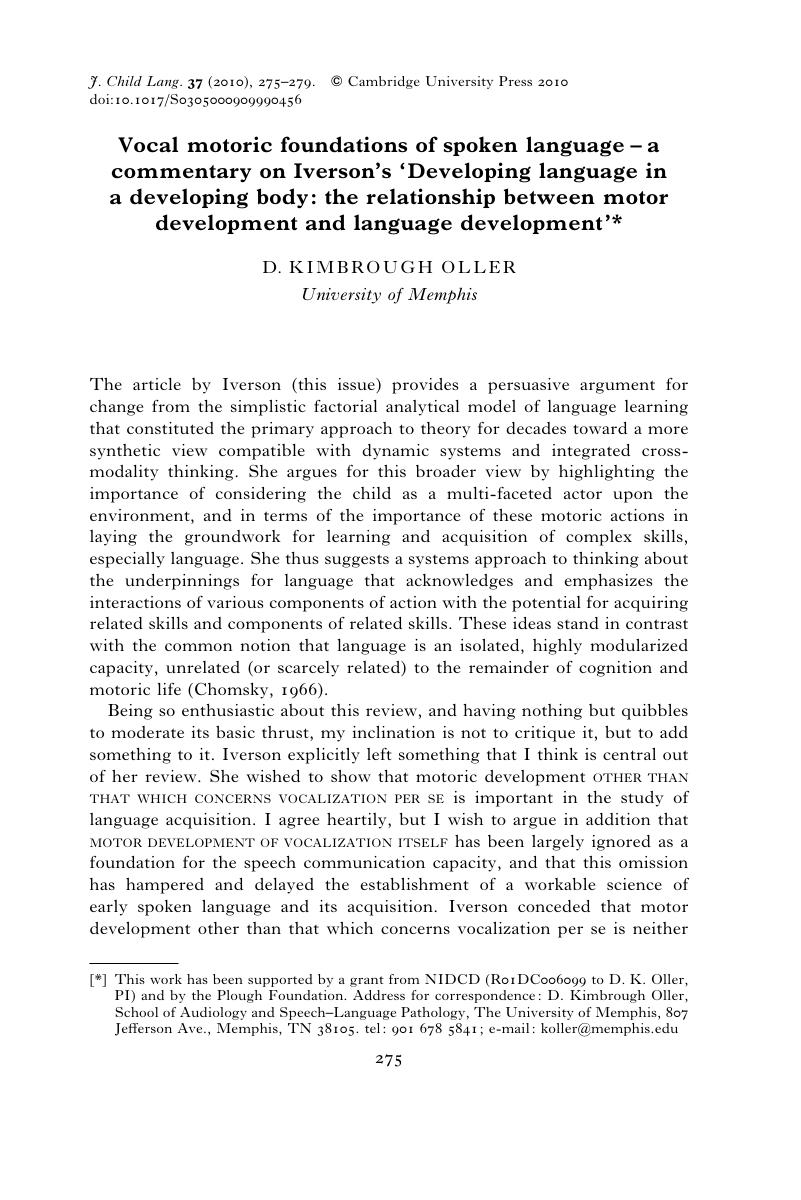No CrossRef data available.
Article contents
Vocal motoric foundations of spoken language – a commentary on Iverson's ‘Developing language in a developing body: the relationship between motor development and language development’*
Published online by Cambridge University Press: 21 January 2010
Abstract
An abstract is not available for this content so a preview has been provided. Please use the Get access link above for information on how to access this content.

- Type
- Review Article and Commentaries
- Information
- Copyright
- Copyright © Cambridge University Press 2010
Footnotes
[*]
This work has been supported by a grant from NIDCD (R01DC006099 to D. K. Oller, PI) and by the Plough Foundation.
References
REFERENCES
Griebel, U. & Oller, D. K. (2008).
Evolutionary forces favoring contextual
flexibiliity. In Oller, D. K. & Griebel, U. (eds),
Evolution of communicative flexibility: Complexity,
creativity and adaptability in human and animal communication,
9–40. Cambridge,
MA: MIT Press.Google Scholar
Jakobson, R. (1941).
Kindersprache, aphasie, und allgemeine lautgesetze.
Uppsala: Almqvist and
Wiksell.Google Scholar
Koopmans-van Beinum, F. J. & van der Stelt, J. M. (1986).
Early stages in the development of speech
movements. In Lindblom, B. &
Zetterstrom, R. (eds),
Precursors of early speech,
37–50. New
York: Stockton
Press.Google Scholar
MacNeilage, P. F. (1998).
The frame/content theory of evolution of speech
production. Behavioral & Brain
Sciences
21(4),
499–546.Google Scholar
Oller, D. K. (1980).
The emergence of the sounds of speech in infancy.
In Yeni-Komshian, G., Kavanagh, J. &
Ferguson, C. (eds),
Child phonology, Vol. 1: Production,
93–112. New
York: Academic
Press.Google Scholar
Oller, D. K. & Griebel, U. (2005).
Contextual freedom in human infant vocalization and the evolution
of language. In Burgess, R. &
MacDonald, K. (eds),
Evolutionary perspectives on human development,
135–66. Thousand Oaks,
CA: Sage
Publications.Google Scholar
Papoušek, M. (1994). Vom
ersten Schrei zum ersten Wort: Anfänge der Sprachentwickelung in
der vorsprachlichen Kommunikation.
Bern: Verlag Hans
Huber.Google Scholar
Snowdon, C. (2004).
Social processes in the evolution of complex cognition and
communication. In Oller, D. K. & Griebel, U. (eds),
Evolution of communication systems: A comparative
approach, 131–50.
Cambridge, MA: MIT
Press.Google Scholar
Stark, R. E. (1980).
Stages of speech development in the first year of
life. In Yeni-Komshian, G., Kavanagh, J. &
Ferguson, C. (eds),
Child phonology, Vol. 1: Production,
73–90. New
York: Academic
Press.Google Scholar
Thelen, E. (1981).
Rhythmical behavior in infancy: An ethological
perspective. Developmental
Psychology
17, 237–57.Google Scholar
Thelen, E. (1995).
Motor development: A new synthesis.
American Psychologist
50(2),
79–95.Google Scholar


